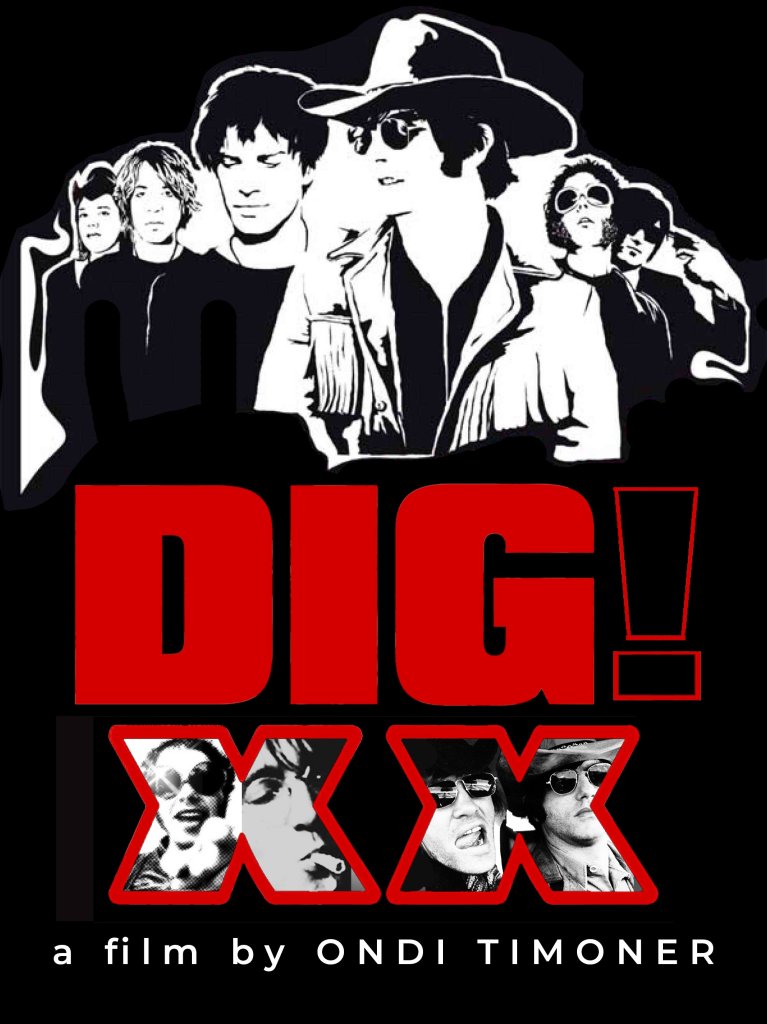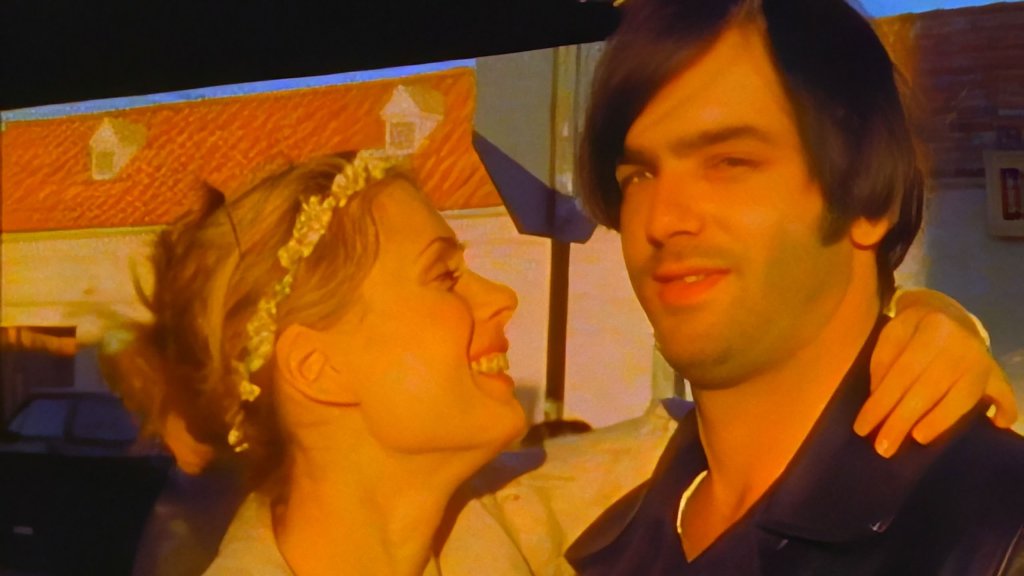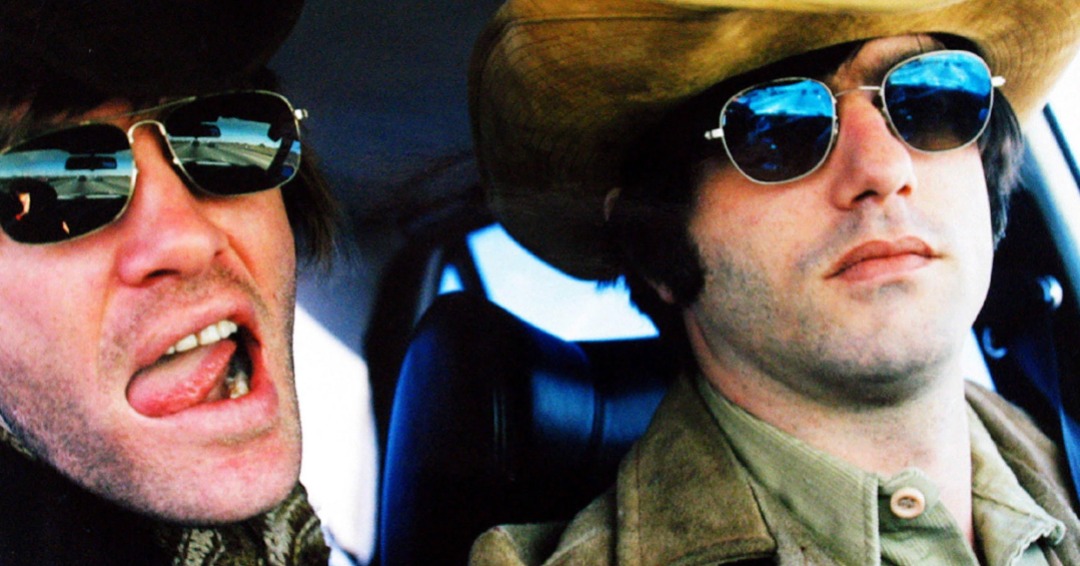Sundance Celebrates Its 40th Anniversary and Iconic Film adds 40 Minutes of Extra Footage
Sundance 2024 is the fortieth anniversary of the festival’s first workshops, and the festival’s programmers brought back eight films from the last forty years that they felt represented Sundance’s incomparable history best for this momentous occasion in independent film.
One of those eight films is one of the greatest rock documentaries that have ever been made, Ondi Timoner’s Dig! While some of the other films that are returning are restorations, some in 4K, as usual, Dig! has brought even more to the table. DIG! did win the Grand Jury Prize for Documentary when it premiered in 2004. It makes sense that a film about a fiery group of individualists who had their own ideas about art and fame would win the prize at Sundance.
Not only is the film restored, but the filmmakers Ondi and David Timoner, who spent seven years filming the two rock bands, The Brian Jonestown Massacre and The Dandy Warhols, as they recorded albums, partied, did drugs, joked, toured, fought, and became rivals, went back to the archives to unearth additional footage.
The new version will be screened today and at its premiere on Tuesday, January 23, as well as during the online program, and has 40 minutes of additional footage. You can purchase tickets here. I’ve seen it, and it is a different and even better film.
Dig! XX gives crucial context to the documentary with the additional footage but also with the added narration of BJM tambourine player and writer Joel Gion, who gives a voiceover representation of The Brian Jonestown Massacre and a different perspective that the first version lacked.
In the original version, occasionally, Gion would make asides directly to the camera and the new Dig! follows through more fully with those moments. His puckish presence does a lot to show both sides more accurately, and he is a charming raconteur.

The bands were the best of friends and creative collaborators who suddenly became, if not worst enemies, something less than friends as they navigated the treacherous world of the recording industry. It’s not easy for anyone to chart their own path in music industry and their attempts to be true to themselves had a cost.
I spoke with Ondi and David Timoner about coming back to Sundance, revisiting an iconic film that they made, and what it is like to create a film that rockstars, rock fans, and independent film fans love.

Dolores Quintana: I imagine it would be very exciting to take the first film that you ever brought to Sundance back to the Festival. I assume this was the first.
Ondi Timoner: This is the first. I was so overwhelmed. I had just given birth to my son. He was 11 weeks old. I kind of had no idea what Sundance really was. I didn’t even know it was their 20th anniversary [in 2004]. Now we have this new edition of Dig!, Dig! XX, and now it is Sundance’s 40th. I’ve had five films there since then. It is a return home for Dig!
Dolores Quintana: Why did you decide to revisit Dig! twenty years later?
David Timoner: Well, we knew we had all of this amazing footage. When we made Dig!, we were young. The first thing that Sundance said to us was, “We love your film, but can you shorten it a little bit?” So we cut some stuff out. Then it became it became this cult classic that it’s become and people were like, “Do you have any more footage?” And we knew we had more footage. We knew we had amazing footage; we knew we had these amazing scenes that we just wanted to…we realized it’s been 20 years; the footage was sitting in Ondi’s garage, slowly decaying on metal particle tapes.
Ondi Timoner: We started filming 27 years ago. So the material is almost thirty years old, and tapes, on average, don’t last that long. So it’s a miracle that they even existed. Thanks to current technology, we were able to upscale them frame by frame. But it was really our last chance to dig into the archive, we felt. People have asked us for years, “Can you make Dig! 2?” I didn’t want to follow those bands again. [Doing] that was our entire 20s. We grew up with those bands. You know, there are only so many years in a life, and I have other films I want to make. So that wasn’t going to happen.
But it was always the next question: “Could you release some outtakes?” What we’ve come up with, and really, I give the credit to David on this new edit. I edited the original Dig!, and he edited this one. It’s really like a seamless new film, but all of the old parts are still there. Forty minutes of new material, and we chose it really carefully. Like, what adds context? What gives the audience something that they didn’t have in the first one [with] what is now a famous scene? The Viper Room, for example. Why did that fight happen?
David Timoner: Yeah, a little more backstory.
Ondi Timoner: And what happened as a result of that? The Viper Room scene was spoofed word for word on The Gilmore Girls. We are able to show what impact Dig! had on the culture, So it’s actually been a very enjoyable experience coming back to this film and reimagining what it could look like and Joel’s narration.
David Timoner: Yeah, that’s crucial.
Dolores Quintana: When I first heard about this, I was actually at the Brain Dead Studios screening back in July.
David Timoner: Wow, cool, man.
Dolores Quintana: When you screened the film.
David Timoner: Yeah, the 35mm
Dolores Quintana: As soon as I heard about the screening, I basically got a brainwave. I thought, wait a minute. Plans are being launched.
David Timoner: We were still like so early in the process. Our guy, Zachary, who came out to dig through our archives, arrived that night; we were just like, oh my god, we didn’t know what we had just bitten off.
Ondi Timoner: It really helped us that some kids came in, and they just dedicated themselves to digging through the archive. We’d say, hey, we should look at The Brian Jonestown going to the UK. We never put that in the original cut, and what actually happened to get Anton, you know what I mean, and then he’d go digging through all the archives.
Dolores Quintana: I was wondering about the print that you showed at Brain Dead Studios. I was wondering if is there a difference between the Sundance cut and what was commercially released.
Ondi Timoner: Yeah, I had to go back and change some things, as is typical after the premiere. But it wasn’t significantly different. I’m trying to remember what was different. Well, there were certain rights, things like music. There was a record company guy who was trying to take like half of the music out.
David Timoner: Oh right, we had to take all the TVT music out.
Ondi Timoner: We had to take some music out and change some things around. But essentially, it was the same. We changed out some songs; we probably changed out a few shots and made it stronger. I had to do the same thing with We Live in Public after Sundance; I had to change out a couple of things.
You run out of time. As artists, you can always make something better. But then the bell dings, and…Sundance has been really helpful in that regard. Because David and I just to [continue] to tweak [with the film] in a way. Same thing with the original Dig!, We started the film together, and then I edited the film, though, for four years. I probably would have just kept going if it wasn’t for Sundance.
David Timoner: You’d still be at it.
Ondi Timoner: Maybe it was actually because I got pregnant. When I won the Grand Jury Prize, I thanked my son for the deadline I couldn’t push in my speech.
Dolores Quintana: where did the idea of having Joel do his narration come from?
David Timoner: I started I started following Joel. I still listen to the Brian Jonestown Massacre in The Dandies. I’m still a fan. He started a Patreon page. I started subscribing to it, at first, just to see what was going on. Then, every week, I would wait for the next episode because he’s a great writer. He’s coming out with a book. He’s a hilarious writer. It’s very Hunter S. Thompson-esque. He is very much in that 70s, rock-style journalism, that Lester Bangs-type thing. So, I just loved his writing.
When things were sort of falling together, we started coming up with the idea to make this version. There were a lot of these scenes that we wanted to include to enhance and tell the backstory, and we needed a narrative device to do that. It just makes natural sense. Let’s call Joel because Joel’s written about this. He’s sort of chronicled this already. It’s coming out in his book. I mean, there are different versions, [this is] obviously, his memory, but…
Ondi Timoner: You sent me 250 pages, and I never got to listen to them. Then, as we were trying to figure out what scenes where to send Zach, our archivist slash production intern, where do we send him to in the archive? We started listening to Joel’s stories to try to figure out what should we add to this version. Then I called David, and I asked David, “Do you have a relationship with Joel now through Patreon?” I hadn’t kept up with Joel. Do you think you could ask him like if he would participate in this version?
David had been supporting his work and all that over the years, and they had maintained a relationship. So David called him, and he said sure. It was a big breakthrough for us and has been the gift that keeps giving. Because everything we wanted to add, even the new stuff like the last 20 years. The brilliant ending that David created with Joel’s voiceover made it possible; it wouldn’t have been possible to bring the story to today without Joel.
Dolores Quintana: When I was at the screening in July, the people behind me were discussing the film. One said I’ve never heard this story. This band, The Brian Jonestown Massacre. Do they even still exist anymore? This is such a tragedy. I turned around and said, No, they’re literally touring the world right now.
David Timoner: It’s so cool to see.
Dolores Quintana: They had gotten the impression from the film that the Brian Jonestown Massacre was just kaput.
Ondi Timoner: In 2004, they were.
David Timoner: I don’t know where Anton was, but he was coming out of rehab. He hadn’t yet licensed his music to Boardwalk Empire. I mean, that’s where the story ended at that point.
Ondi Timoner: Then it became a sensation and then everybody started discovering the band. But I mean, Anton was never going to give up anyway. But his star certainly rose in conjunction with the rise of Dig!
Dolores Quintana: When you are making a documentary, how do you approach crafting the story?
Ondi Timoner: Personally?
Dolores Quintana: Yes, how do you let whatever happens while you’re filming lead you to where the film needs to be?
Ondi Timoner: So, a lot of the magic of Dig! is just kind of knowing when to show up. The first few years, we were there all the time. My feeling was to let me film life unfolding. So I can look back and connect the top moments and bring the audience on the journey. Because at that point, in the early 90s, nobody was watching documentaries because they were considered too good for you to be entertaining. Like eating your vegetables. It wasn’t like the Cinema Verite of the 60s. What appealed to me about the documentary was the idea of being able to take the audience and have them be very present in an unfolding, suspense-driven narrative.
If the narrative could be as exciting or interesting as real life, it would be even more interesting than real life because it’s real. But in order to do that, you have to be there for it, right? You can’t write it. You know, I write screenplays, too, and to jump 10 years, that takes 10 seconds on a script. But in a doc, you have to be there ten years later. Time really provides the greatest narrative. We were kids. I was 23. David was 21 when we started this movie, and we filmed everything. So we ended up with 1000s of hours of footage, and that meant I was editing for four years.
During that time, of course, the band’s relationship transformed from being best friends to bitter rivals. Still, there was this sort of star-crossed love relationship between the two lead singers, where each one possessed what the other didn’t have. So, I would just try to figure out where to show up over those latter four years. I couldn’t film them all the time. But since the story was still going, well, let me keep up with it. When I would hear certain things like the Knitting Factory [concert], for example.
I thought, well, I have to see him right now, and lo and behold, when I went into the club, I heard his voice intermixed with the loudspeaker. There was music, but almost like this Wizard of Oz voice mixed in. I walked behind the curtain, and there he was, talking to the audience. Before the performance, subliminally talking to the audience with this Hello Kitty lamp and in this Jesus poncho. A Jesus fish poncho, and I just thought, oh my god, what is going to happen here? Lo and behold, he was violent, kicked the guy in the head, was arrested, and that was the end of the movie.
But it was stuff that where the two bands are going to meet here, or this is a big moment for The Dandy Warhols, their star is rising in England. We have to show up for that. So we upped the game, and we shot on film to kind of mirror it. Trying to make the film feel like what it is. That is another thing that I tried to do. I tried to have it look and feel like what it is we’re portraying [in the film].
Since Dig! spanned seven years, and we were just children when it started, we didn’t have the technology that we had when it ended. The technology sort of grew, and the format of the film grew with the success of the band. As we grew, but narratively, it was the basic idea that you have to set up these two bands. What are we looking at here? Set up that there’s sort of this dynamic, this collision of art and commerce. We started with 10 bands.
I had an experience with a film coming out of Yale that was about a woman in prison. I came to Los Angeles to try to turn it into a movie that would reach a bigger audience, like a movie of the week or something. It was getting so distorted in the process, and that’s why we started looking at bands on the verge of getting signed. It was almost to answer the question for ourselves. Can we maintain our integrity and reach a mass audience? The answer came with Dig! because Dig! came out exactly as we intended it. We had Sundance, right, thanks to Sundance.
David Timoner: We went down the road with MTV, actually.
Ondi Timoner: It would have been so distorted as an MTV series. Bad times, we just had no money. Neither band was selling records to the extent that would get us money [that they needed to finish the film] Then, when we finally found a great investor, Anton threatened his life. So he pulled out. We constantly were looking for money. MTV said this is brilliant. Let’s do it. Then, when they dug into the material, they’re like, too many curse words, too many cigarettes. Thank God. But yeah, it’s an iconic story. It’s a story of two people, really, and their bands.
But through that, you can look at the collision of art and commerce, friendship and madness, and really what it is to be an artist. It feels like a lot, even though it’s hyperbolic, so many musicians have this film on their buses. I came to find that out when I was shooting Lollapalooza because Perry Farrell asked me to shoot Lollapalooza right after Dig! So, I shot the next three years of Lollapalooza. I would get every band in my studio, from Lady Gaga to Ben Harper to Iggy Pop, on down the line because they all loved Dig! so much, and that’s funny to me. None of them probably living as quite as dysfunctional a life as what you see in this film, but they all related to it, still.
David Timoner: They all had this fantasy where they could tell the record company to f*ck off like Anton does, you know?
Dolores Quintana: I think that, particularly rock and roll musicians, they live a different kind of life, they’re different. They’re a different breed. They’re a little more dangerous than your average pop star.
David Timoner: Yes.
Dolores Quintana: They get into fights. They curse. They do drugs. They’re not the people who are going to be mowing the lawn every Sunday. They’re just not like that. That’s not surprising to me, really. It is a film that musicians would understand. I actually think that Dig! was a precursor to a lot of what filmmakers do in documentaries now and also in Reality Television.
David Timoner: Yeah.
Dolores Quintana: It had a very big influence, not just on rock culture but on other types of musicians, because, as it turns out, Anton was actually right about record companies. He’s been trying to warn people about contracts from the beginning and he hasn’t stopped. I think musicians are finally starting to realize the truth of what he said in your film. I think the film has had a big influence on modern pop culture.
Ondi Timoner: That’s a really high compliment. Thank you.
David Timoner: About what you said about Reality TV. I feel like we were kind of obsessed with the idea of Reality TV before Reality TV came out. Just shoot everything, and there’s a story. We know it’s there. If we just record everything, like that first season of The Real World. I love that first season.
I work in Reality TV, and it’s gone far from that. Far from shooting everything and making a story. It’s a lot more like planning a story and making a story now. But the original idea. I think we had this idea of, like, oh, the tape is cheap, and we can just shoot everything, and we’ll get it. We’ll get reality.
Dolores Quintana: You’ll find it in all the footage.
David Timoner: Exactly, exactly.
Ondi Timoner: Yeah, it was the idea. Now, we still do that in my films lately. Last Flight Home, we filmed everything. Absolutely everything. Our father was totally open to being filmed and said, you’re instinctively on the right track. From the moment he came home to do medical aided dying and the waiting period, we filmed everything, 500 hours of footage, and that is really the best way to go. But when you’re filming over many years, you also need to limit what you’re filming. That’s the thing.
David Timoner: We only have so much time on this planet. Right. So that’s the trick.
Ondi Timoner: The trick is also to keep intricate notes. Note what you’re filming. We’re filming a new documentary, and we’re filming a lot right now. It’s all pinpointing in the moment, those highlights that, you know, are going to be the building blocks of the narrative. I still think that taking the audience along for the ride is the most satisfying kind of documentary to make. I just think it’s no accident. It’s no coincidence, rather, that my two films that won at Sundance are Dig! and We Live In Public. Dig! was shot over seven years and We Live in Public, over ten years. Dig! is 2500 hours of footage, and We Live in Public is 5000 hours of footage.
It is having that collection to pull from to really allow the audience to be the jury and viscerally experience being there. Then, they can grapple with “What would I do.?” Another crucial thing is making a tether for the audience to be able to connect with and to have compassion for the main character, no matter how irrational or abusive or crazy they seem to be. For Dig!, it is within the first twenty minutes that you meet Anton’s mom and dad. You get a sense of where some of the pain that is driving his intense creativity but also where some of his erratic behaviors come from. That’s really important to do as well.
Something [that I found] in finishing and editing Dig! I had to really work on it because I was upset with Anton by then and the way he was destroying every opportunity. I had to come to realize that when I showed early cuts to people. They said, well, we just don’t like your protagonist. I realized that’s because I wasn’t reaching deep enough to realize and to get people to understand early, here’s where his pain comes from. Let’s feel for him, let’s have an emotional tether, but also, here’s why he’s significant. So even though you’re gonna see him do all these sorts of horrible things to his bandmates, he changed the course of music in certain ways, and he is worth watching. Those were the two crucial elements in the original Dig! that needed to really get highlighted in order to finish the film successfully.
Dolores Quintana: I think that you’ve actually added more stuff there that gives that additional information, not just about Anton and the members of his band, but also to people in The Dandy Warhols. It’s very instructive and shows other sides to people and their actions.
Ondi Timoner: Did you like it as much as the original?
Dolores Quintana: I liked it more, because it seemed like a more complete version.
David TImoner: That’s what we wanted. We wanted people to know why they got into a fight in the Viper Room. We wanted there to be real context. To really understand things, you know.












